
AI orchestration platforms are transforming how businesses manage complex workflows by unifying access to multiple models like GPT-5, Claude, and Gemini. These tools simplify operations, reduce costs, and ensure compliance, making them essential for enterprises navigating today’s AI ecosystem. Below is a quick overview of the top platforms shaping 2025:
These platforms range from enterprise-grade solutions to open-source tools, each addressing unique business needs like governance, scalability, and cost control. Whether you're a startup or a large enterprise, there's a platform to streamline your AI workflows.
| Platform | Best For | Key Features | Pricing Model | Deployment Options |
|---|---|---|---|---|
| Prompts.ai | Enterprises managing multiple LLMs | 35+ AI models, TOKN credits, compliance | Pay-as-you-go | Cloud, On-premises |
| OpenAI | AI-first teams | GPT-4, DALL-E 3, Whisper, APIs | Token-based pricing | Cloud |
| Anthropic | Regulated industries | Claude models, long-context reasoning | Token-based pricing | Cloud |
| Gemini | Enterprise ecosystems | Google Cloud integration, automation | Usage-based | Cloud |
| Groq | Real-time AI tasks | Ultra-low latency, high-speed inference | Custom pricing | On-premises |
| Mistral | Teams needing transparency | Open-weight models, cost control | No licensing fees | On-premises, APIs |
| Ollama | Privacy-focused organizations | Local-first, CLI-based workflows | Hardware-dependent | Local |
| Together AI | Custom AI deployments | Hosted open models, fine-tuning tools | Custom pricing | Cloud |
| Kubeflow | Kubernetes-based environments | Modular ML pipelines, open-source | Free | Cloud, On-premises |
| Apache Airflow | Complex workflows | DAG-based pipelines, Python integration | Free | Cloud, On-premises |
| Domo | Non-technical teams | No-code automation, data integration | Usage-based | Cloud |
| Domino Data Lab | Enterprises | Limited public details | Custom pricing | Cloud, On-premises |
Select a platform that aligns with your team’s needs, technical expertise, and budget to maximize efficiency and scale your AI capabilities.
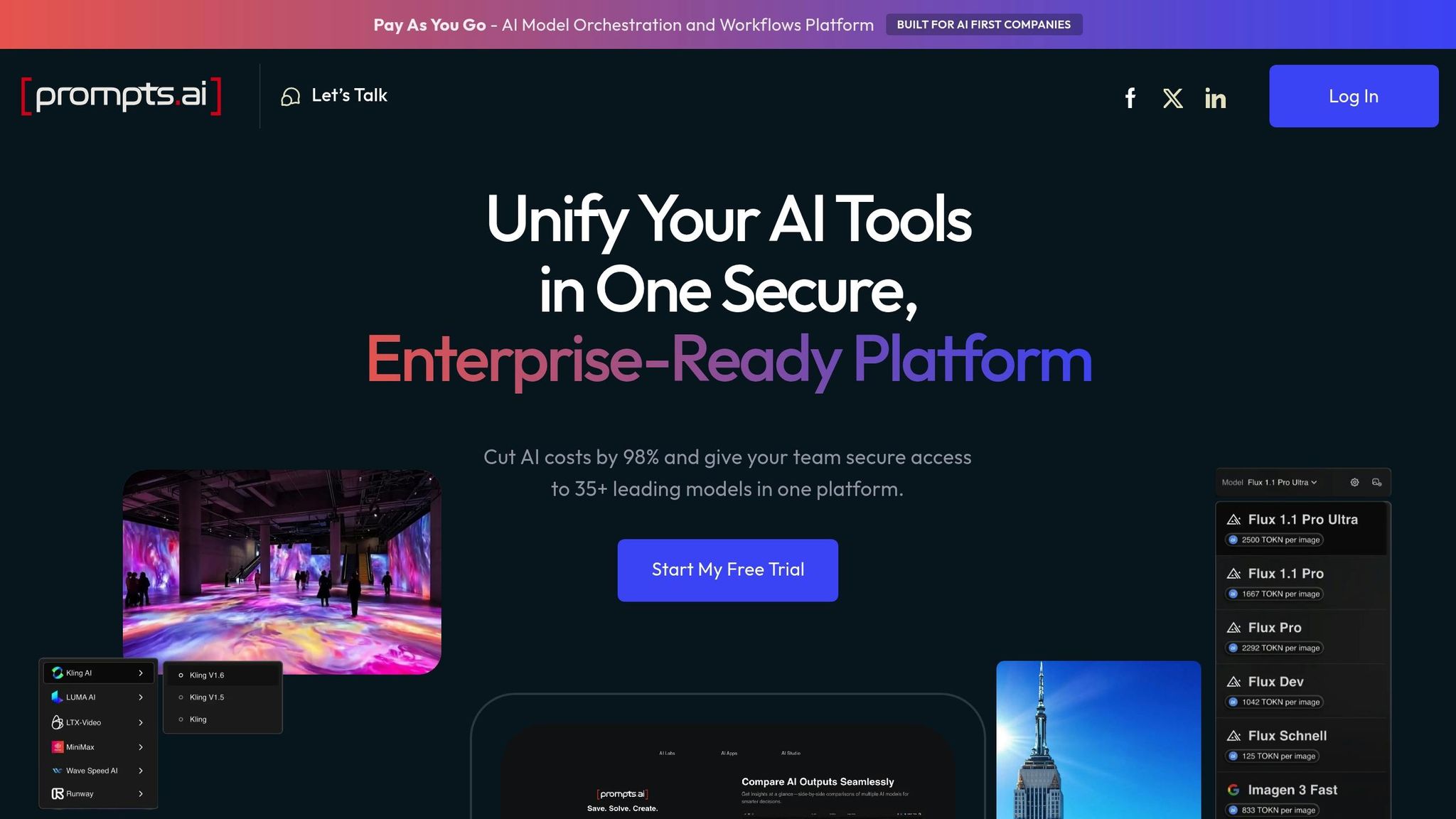
Prompts.ai is a powerful AI orchestration platform designed to simplify how U.S. enterprises manage and use AI tools. By consolidating access to over 35 top-tier AI models - such as GPT-5, Claude, LLaMA, and Gemini - into a single, secure platform, it eliminates the hassle of juggling multiple subscriptions and fragmented workflows.
With Prompts.ai, businesses can perform instant, side-by-side comparisons of various large language models. Its interoperable workflows, available in Core, Pro, and Elite plans, allow users to integrate specialized AI models - like those for content creation or data analysis - into cohesive automated processes. Thanks to its connector-based architecture, the platform integrates seamlessly with existing enterprise systems. This approach not only avoids vendor lock-in but also ensures flexibility as new models and technologies emerge, enabling businesses to create efficient, automated workflows without disruption.
The platform simplifies automation with drag-and-drop pipeline builders and event-driven triggers. These tools make it easy to automate tasks like model retraining and deployment based on data updates or performance metrics, reducing manual effort. By combining these features with Prompts.ai's orchestration capabilities, users can design complex, multi-step AI workflows that connect various models and data sources - all while maintaining centralized oversight.
Prompts.ai is built with enterprise governance in mind. It includes features like audit trails, access controls, and model versioning, which help organizations meet stringent regulatory requirements such as GDPR and CCPA. The platform also adheres to SOC 2 Type II, HIPAA, and GDPR standards, with continuous monitoring through Vanta. As of June 19, 2025, the platform began its SOC 2 Type 2 audit, reinforcing its focus on enterprise-grade security. Additionally, its dedicated Trust Center offers real-time updates on security policies, compliance measures, and overall platform transparency - critical for businesses needing to balance regulatory compliance with operational efficiency.
Prompts.ai takes the guesswork out of cost management with real-time dashboards that track resource usage, model inference costs, and infrastructure expenses, all displayed in U.S. dollars. Its pay-as-you-go TOKN credits system replaces recurring subscription fees, aligning costs directly with usage. This model can result in significant savings, with the platform claiming AI software cost reductions of up to 98%. Features like budget alerts and cost analytics also help businesses make smarter decisions, such as using cost-effective models for routine tasks while reserving premium models for critical applications.
Designed for horizontal scaling, Prompts.ai can handle thousands of concurrent model inferences and manage large-scale data flows with ease. It supports both cloud and on-premises deployments, automatically allocating resources based on workload demands. The platform’s scalability ensures that as enterprises grow - adding more models, users, or teams - they can maintain centralized governance and security without compromising compliance. This makes it ideal for organizations expanding AI adoption across multiple departments and use cases.

OpenAI stands as a key player in AI integration, offering a robust API platform that empowers businesses to incorporate advanced AI models into their operations with proven dependability. Let’s dive into how its unified API makes model interoperability and seamless workflows possible.
The API framework from OpenAI supports a wide range of model variants, including GPT-4, GPT-4 Turbo, DALL-E 3, and Whisper. This unified system allows businesses to switch effortlessly between models like GPT-4 and GPT-4 Turbo, ensuring consistent and reliable performance across various applications.
One standout feature is its ability to enable collaboration between models within a single workflow. For instance, GPT-4 can handle text analysis while DALL-E 3 generates complementary visuals, creating a streamlined content production pipeline that combines the strengths of both models.
OpenAI simplifies workflow automation by integrating tools and supporting webhooks. Webhooks enable real-time model responses, which can be used for tasks like analyzing customer inquiries or generating personalized content dynamically, ensuring timely and efficient operations.
To support businesses in maintaining compliance and brand standards, OpenAI incorporates strong governance tools. Monitoring and content filtering systems help organizations adhere to internal policies and regulatory guidelines. The platform also provides detailed usage analytics, allowing administrators to track API usage and review generated content. Additionally, the moderation API scans for harmful or inappropriate material, safeguarding brand integrity. For enterprises, data handling agreements ensure compliance with stringent regulatory requirements.
OpenAI’s pricing model is straightforward, using tokens as the basis for costs, which are displayed in U.S. dollars. Real-time tracking and billing alerts provide businesses with clear insights into their spending.
Designed to accommodate projects of any size, OpenAI’s infrastructure adjusts automatically to handle fluctuating workloads. A rate-limiting system ensures fair access to resources, while higher limits can be arranged for growing needs. For enterprise users, dedicated capacity options ensure steady response times, even during high-demand periods.
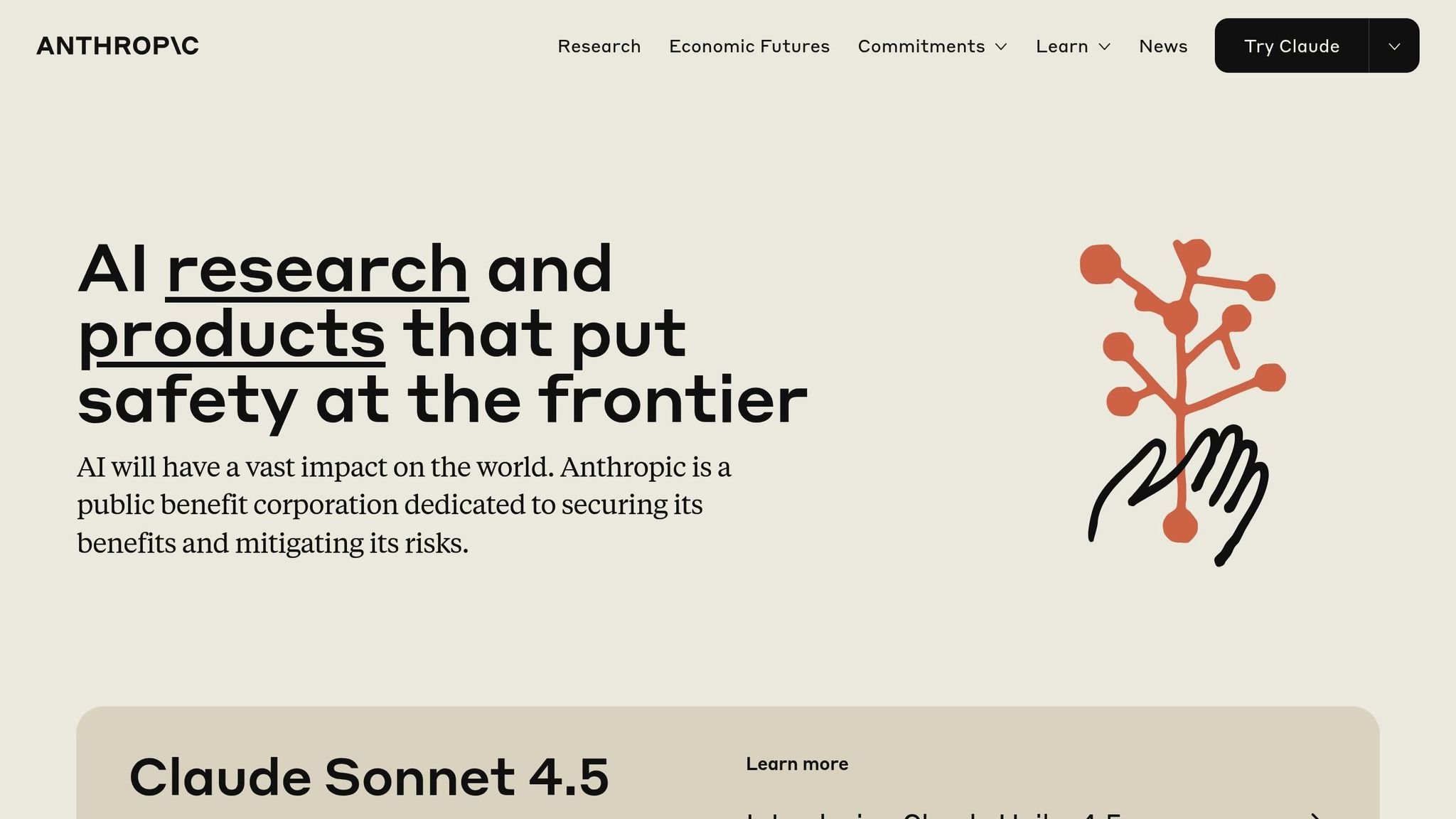
Anthropic's Claude models stand out for their focus on safety, reliability, and adherence to Constitutional AI principles, making them a strong choice for industries with strict regulatory requirements. The platform is designed to meet high governance standards while delivering advanced AI capabilities.
Claude models are built for seamless integration into a variety of AI workflows, thanks to user-friendly APIs. These APIs allow businesses to incorporate Anthropic's tools into their existing systems with minimal disruption. The framework supports compatibility with major orchestration platforms such as LangChain, Microsoft AutoGen, and Vellum AI, enabling organizations to develop flexible, multi-model environments tailored to their unique needs.
One of Claude's key strengths is its ability to handle long-context reasoning. This feature ensures coherence across extended conversations and complex tasks, making it particularly effective for managing multi-step business processes. This capability, combined with easy integration, complements Anthropic's strong governance model.
Anthropic incorporates ethical guidelines and safety protocols directly into its AI through its Constitutional AI approach. This ensures that the platform operates within strict governance standards, which is especially important for industries like finance, healthcare, and legal services. Claude's outputs are designed to be brand-safe, making it a reliable choice for customer-facing applications.
"Anthropic's Claude models are optimized for long-context reasoning, brand-safe outputs, and enterprise reliability. Claude 3 Opus offers high-quality completions in regulated sectors and customer-facing applications. The emphasis on Constitutional AI makes Anthropic a leader in alignment-sensitive deployments." – Walturn
Claude's architecture is built to adjust automatically to changing demands, handling sudden increases in workload without compromising performance. This is particularly beneficial for critical workflows where reliability is essential. The platform also supports multi-model orchestration, allowing businesses to scale individual components of their systems as needed. Integrated governance controls ensure that safety and compliance remain intact, even as usage grows.
Gemini, powered by Google Cloud, is designed to simplify the management of AI workflows within complex enterprise ecosystems. By offering a unified platform, Gemini ensures seamless integration and efficient orchestration across all aspects of AI operations.
With Google Cloud's standardized APIs, Gemini brings together various data formats, making it easier to manage and integrate different AI models under one system.
Gemini takes care of repetitive and intricate tasks by automating model deployment and performance tracking. This approach not only streamlines operations but also ensures better resource management.
Built with responsible AI in mind, Gemini prioritizes governance and compliance. It adheres to industry standards, helping enterprises maintain ethical and regulatory alignment in their AI practices.
Gemini offers real-time cost tracking through Google Cloud, giving enterprises clear insights into their expenditures. Its ability to optimize resource use adds another layer of efficiency, ensuring that budgets are managed effectively.
Leveraging Google’s global infrastructure, Gemini dynamically scales to meet enterprise demands. This ensures consistent performance, high availability, and the capacity to handle distributed workloads with ease.
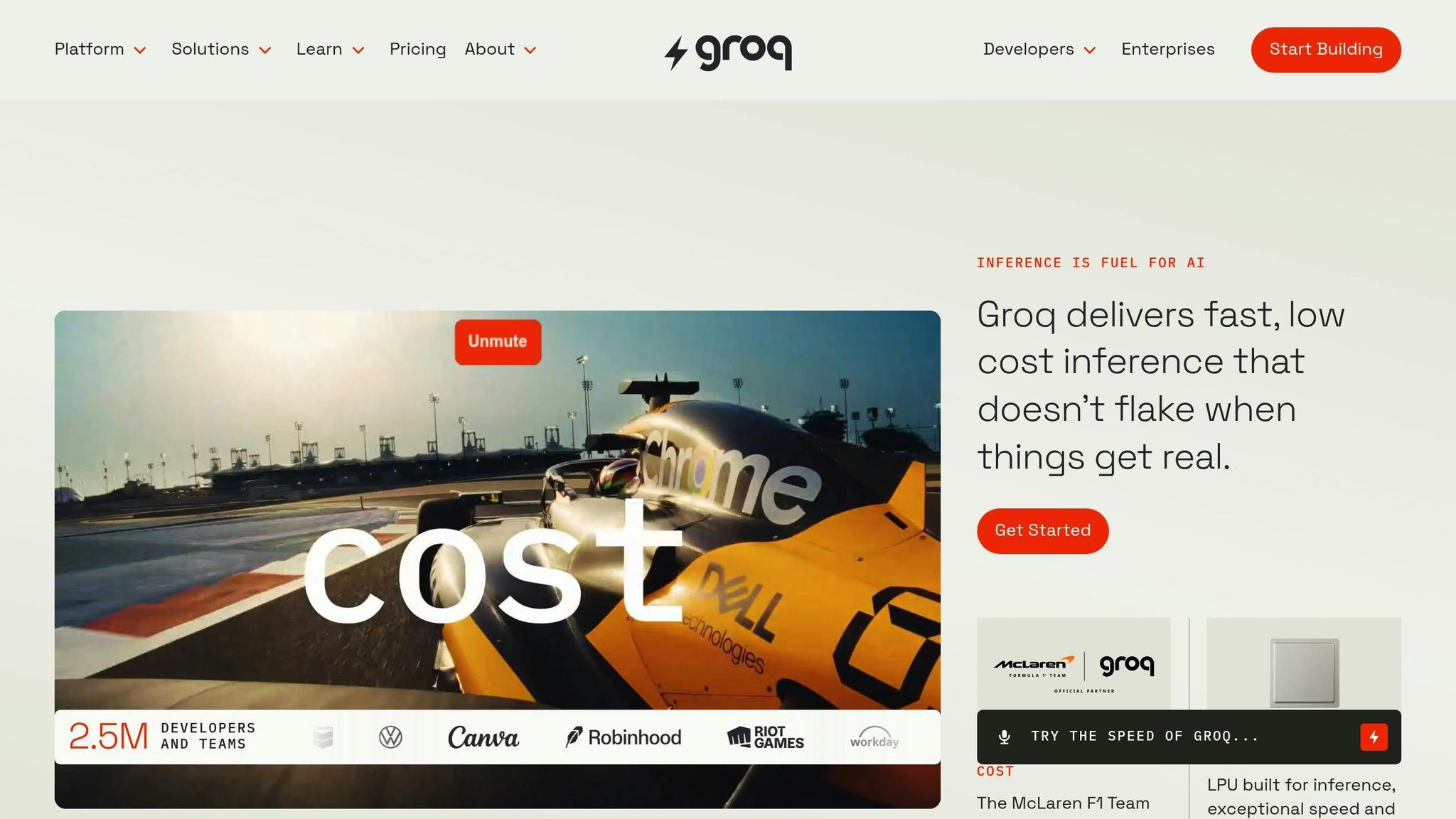
Groq sets itself apart with its unique LPU-based architecture, engineered to deliver ultra-low latency and deterministic real-time inference at an enterprise level. This innovative design ensures organizations can rely on consistent and predictable performance for their AI workflows.
Groq's architecture enables workflow automation with sub-100ms real-time inference, making it perfect for applications that demand instant and reliable responses. Whether it's AI agents requiring quick decision-making, voice applications processing speech in real time, or streaming tools that need steady, low-latency performance, Groq delivers. This precise and reliable performance allows businesses to scale their AI operations without interruptions or delays.
Built to handle growing demands, Groq’s system scales seamlessly while maintaining its hallmark high-speed, consistent performance. This ensures enterprises can expand their AI capabilities without compromising on response times or overall reliability, supporting the smooth growth of their operations.
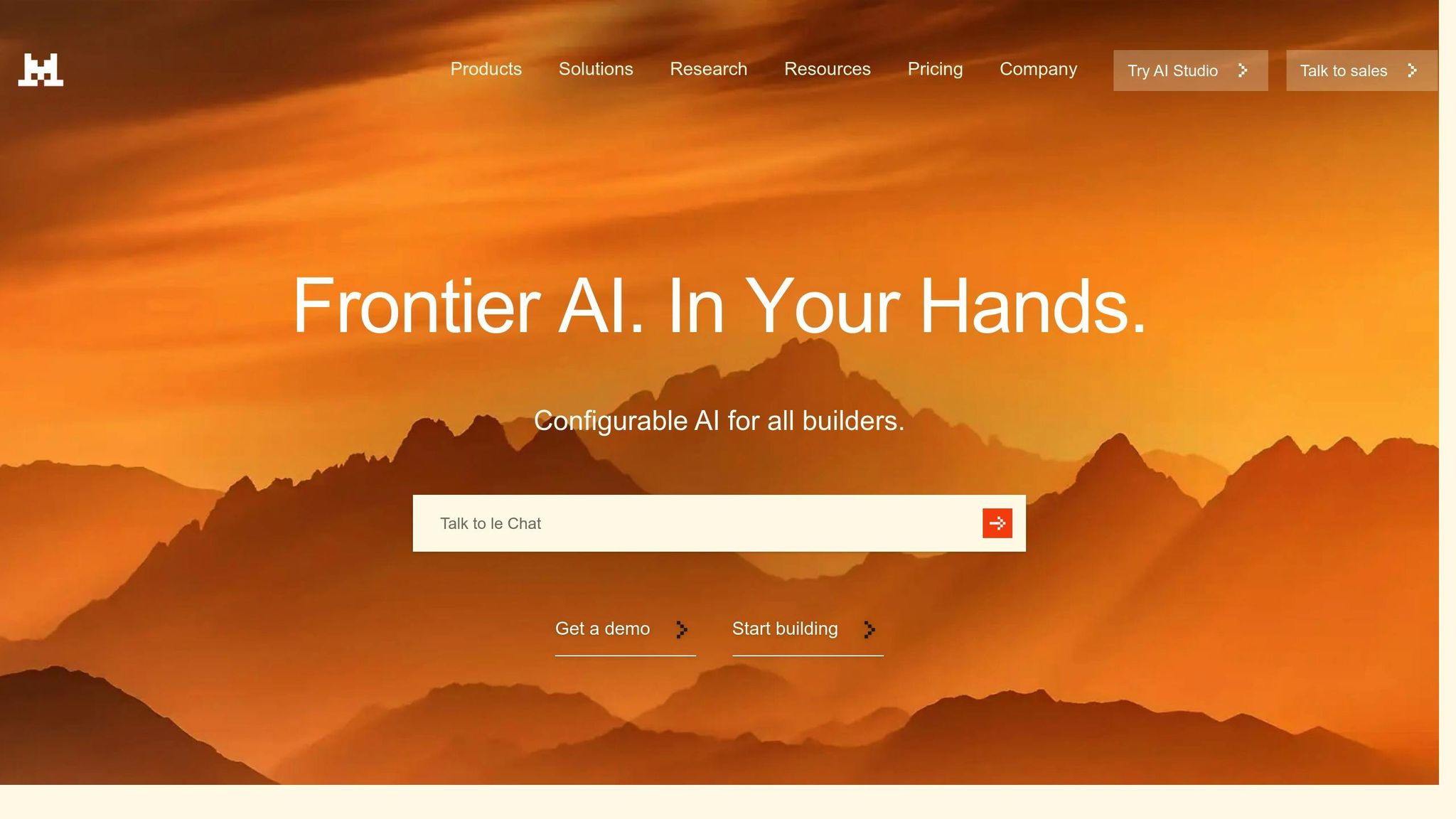
Mistral provides an open-weight model suite designed to offer teams full visibility and control over their AI infrastructure.
With its open-weight architecture, Mistral ensures smooth integration across AI workflows by making model weights accessible. This transparency allows models to be easily incorporated into existing systems, whether through on-premise setups or API-based implementations. The flexibility of its design not only simplifies integration but also helps manage costs effectively.
"Mistral offers a fully open-weight model suite optimized for general-purpose, vision, and code tasks. Its models can be deployed on-premise, fine-tuned with industry datasets, or served through APIs. Mistral appeals to teams seeking transparency, adaptability, and infrastructure control." - Walturn
By removing the need for proprietary licensing fees, Mistral enables organizations to run models on their current hardware, giving them greater control over compute costs. The option to fine-tune models with industry-specific datasets further enhances efficiency, improving performance while reducing the resources required. This approach ensures cost savings scale effectively across various deployments.
Mistral's infrastructure-agnostic framework supports both vertical and horizontal scaling, empowering organizations to adapt and expand their deployments as needed, while maintaining full control over growth.
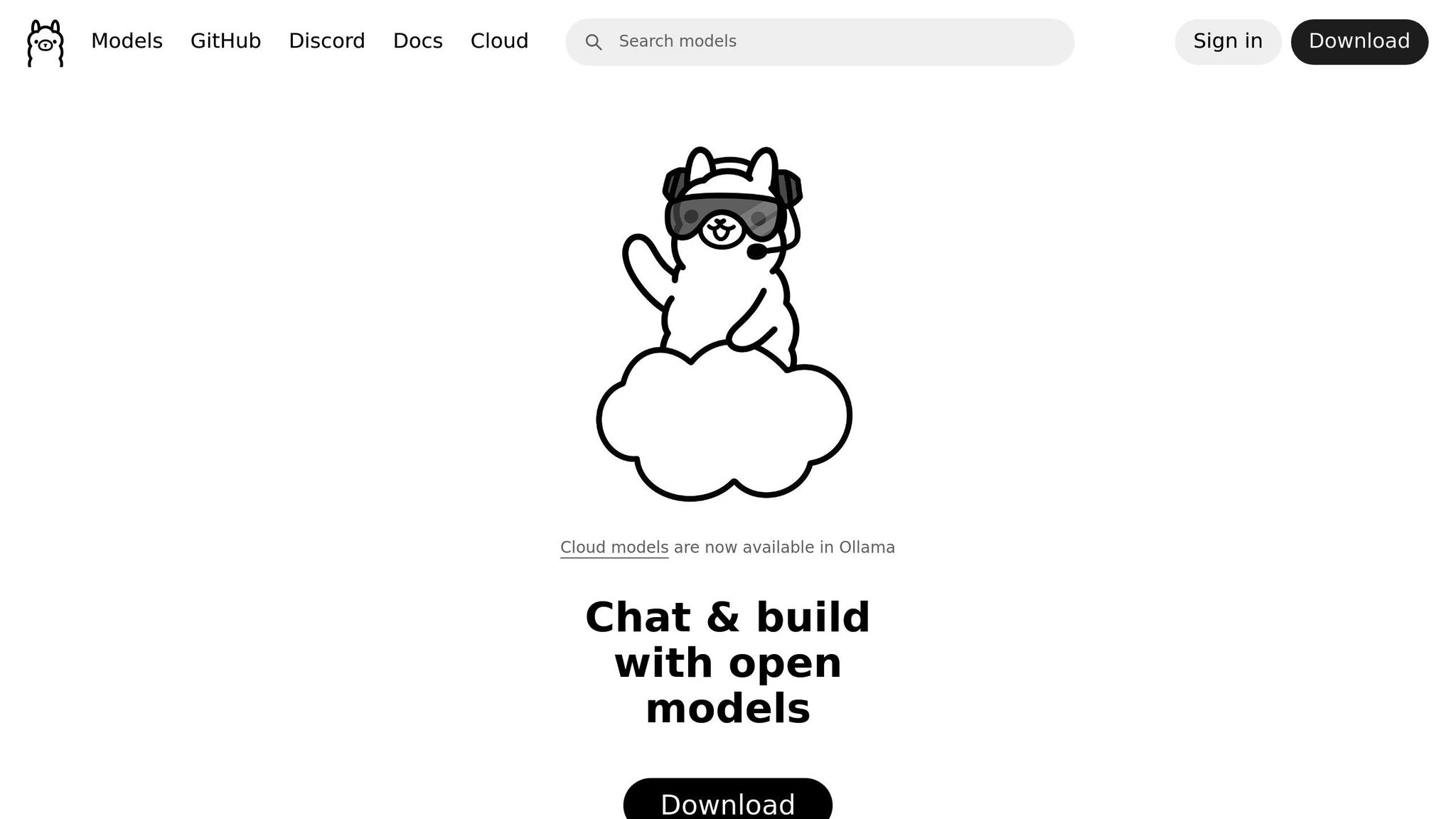
Ollama introduces a local-first approach to AI orchestration, setting itself apart from cloud-dependent systems. By running AI models directly on personal hardware, it eliminates the need for cloud reliance, giving developers greater control over their workflows.
Ollama's command-line interface (CLI) architecture ensures smooth integration into existing AI workflows and frameworks. Developers can operate models locally while seamlessly aligning them with their current development setups. This design minimizes the need for major reconfigurations or cloud-based dependencies.
With its local-first focus, Ollama allows AI models to function entirely on personal hardware. This gives developers complete oversight of their AI infrastructure, enabling easy transitions between model types without leaving the local environment. Full visibility and control remain in the hands of the developer throughout the process.
The platform's CLI interface supports scripting, allowing developers to automate AI model execution and tailor workflows to meet evolving experimental requirements.
Ollama’s adaptable design facilitates the creation of automated local environments capable of managing multiple AI tasks simultaneously. This is especially beneficial for teams working on prototypes, where shifting needs and frequent workflow adjustments are common.
Ollama's local-first framework ensures all data processing stays on personal hardware, aligning with stringent privacy and compliance standards. Since no data leaves the local environment, the platform is particularly suited for organizations with strict data governance policies.
By keeping data in-house, Ollama offers robust privacy protections. Developers focused on maintaining data sovereignty find this feature especially appealing. For regulated industries, the platform provides a secure way to manage AI workflows without exposing sensitive information to external servers or cloud infrastructure.
Running AI models locally on personal hardware helps teams avoid the hefty expenses associated with cloud services. This allows smaller teams or early-stage projects to experiment with AI without the financial burden of ongoing cloud costs.
Ollama’s clear and predictable cost structure is another advantage. Since costs are tied to existing hardware resources, teams gain full transparency over their AI infrastructure expenses. This eliminates the complexity of cloud pricing models and supports cost-efficient experimentation.
Ollama shines in local deployment and offline operations, though its scalability differs from cloud-native platforms. Its strength lies in offering control and privacy, making it an excellent choice for regulated industries requiring on-premises AI solutions.
For teams prioritizing flexibility and fast iteration, Ollama’s local-first design offers significant benefits. However, businesses aiming for large-scale enterprise AI deployments may need to weigh the limitations of scaling with personal hardware against the broader capabilities of cloud-based systems.
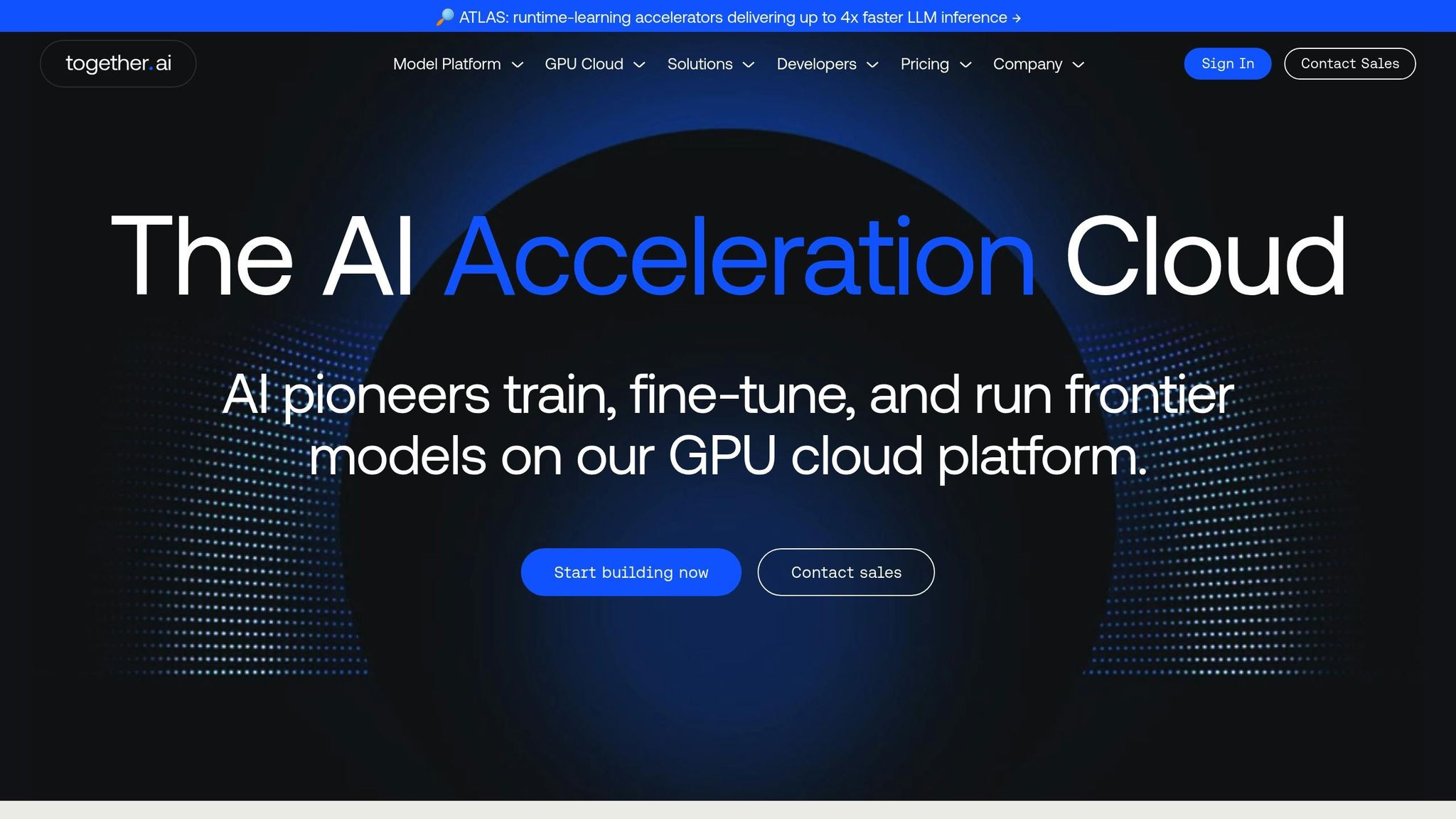
Together AI stands out as a platform offering high-performing hosted open models, designed with the flexibility required for custom AI solutions.
Together AI's design ensures smooth integration across various AI frameworks, thanks to its hosted open model approach. This focus on accessibility allows developers to work seamlessly with a range of model types within a single, unified environment, simplifying the process of building and managing automated workflows.
"Together AI provides high-performing hosted open models with built-in support for fine-tuning, RAG, and orchestration. Its production-ready environment and emphasis on model accessibility make it ideal for teams deploying custom agents or copilots." - Walturn
The platform simplifies complex AI tasks by integrating fine-tuning, Retrieval Augmented Generation (RAG), and orchestration into one cohesive system. By addressing the challenges of fragmented tools, Together AI enables teams to create and manage custom AI workflows with ease. Its infrastructure supports automated processes for building and deploying AI agents or copilots, tailored to specific business needs. This streamlined approach not only reduces complexity but also ensures scalable and efficient deployments.
Together AI's infrastructure is built to adapt to increasing workloads effortlessly. Teams can scale their operations without worrying about managing hardware or cloud infrastructure, as the platform handles these complexities automatically. This hosted model allows businesses to focus on application development, offering a middle ground between fully managed services and self-hosted systems. With built-in fine-tuning capabilities and deployment flexibility, Together AI is particularly beneficial for growing businesses that need scalable AI solutions without requiring extensive DevOps resources. The platform’s automated scaling also ensures smooth workflow management across all orchestration activities.

Domino Data Lab stands out as an AI orchestration platform tailored specifically for enterprise needs. While detailed information on its governance, scalability, and workflow automation features isn't readily available, it is recognized for its enterprise-grade capabilities. For more comprehensive details, refer to Domino Data Lab's official documentation or other reliable sources.
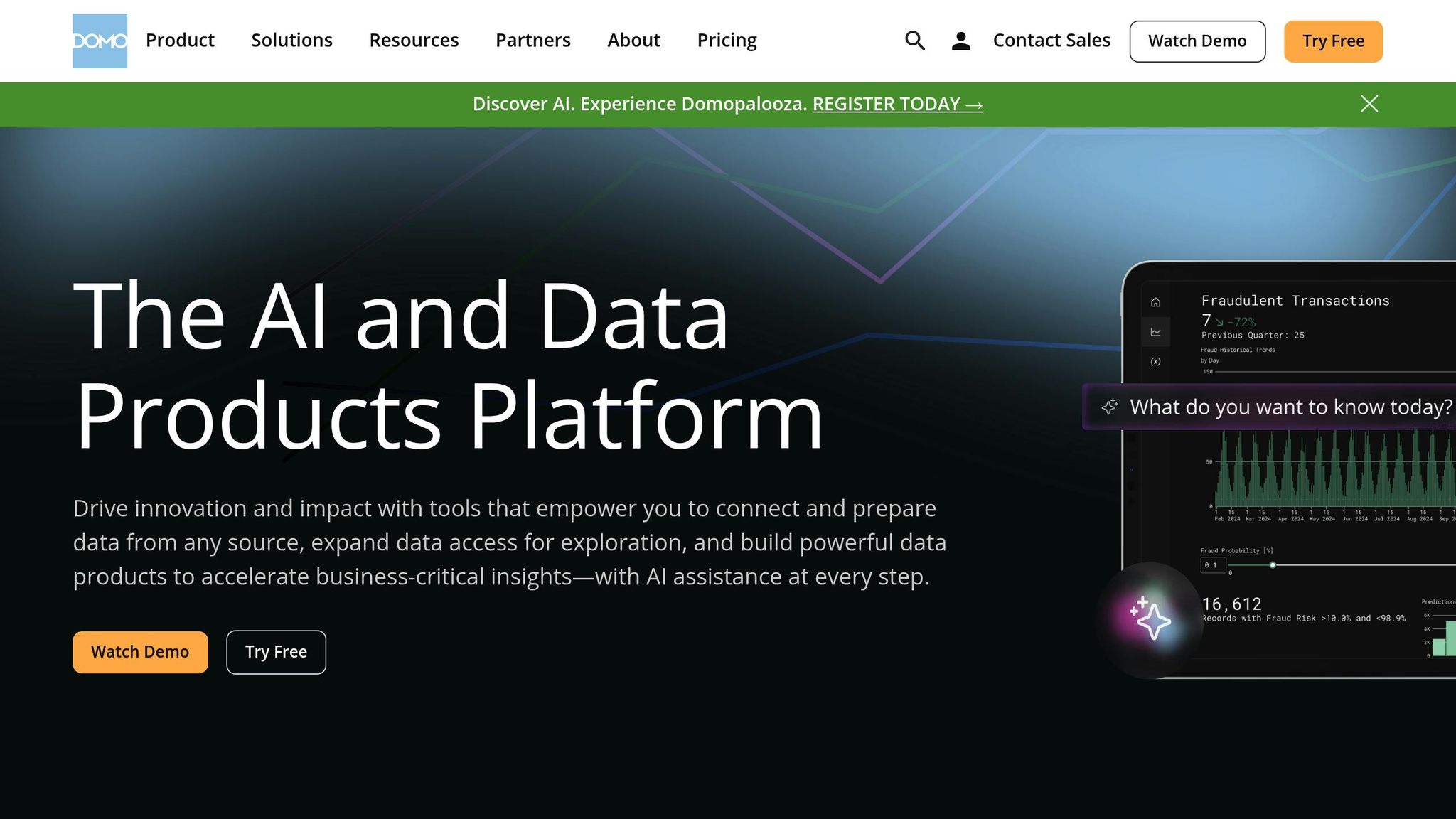
Domo presents itself as a no-code orchestration platform, designed to empower non-technical teams with AI-driven automation.
With Domo, data preparation and forecasting become automated, allowing teams to redirect their focus toward more strategic goals. This approach forms the backbone of Domo's efforts to streamline operations and reduce costs.
Domo integrates data seamlessly, delivering clean and organized datasets that eliminate the need for costly revisions. Its licensing model is based on data volume and usage, so it's essential to assess potential expenses for workflows that involve large datasets or frequent processing.
In addition to operational efficiency, Domo emphasizes secure governance. It offers built-in compliance frameworks and alert systems, helping organizations mitigate risks like penalties or data breaches.
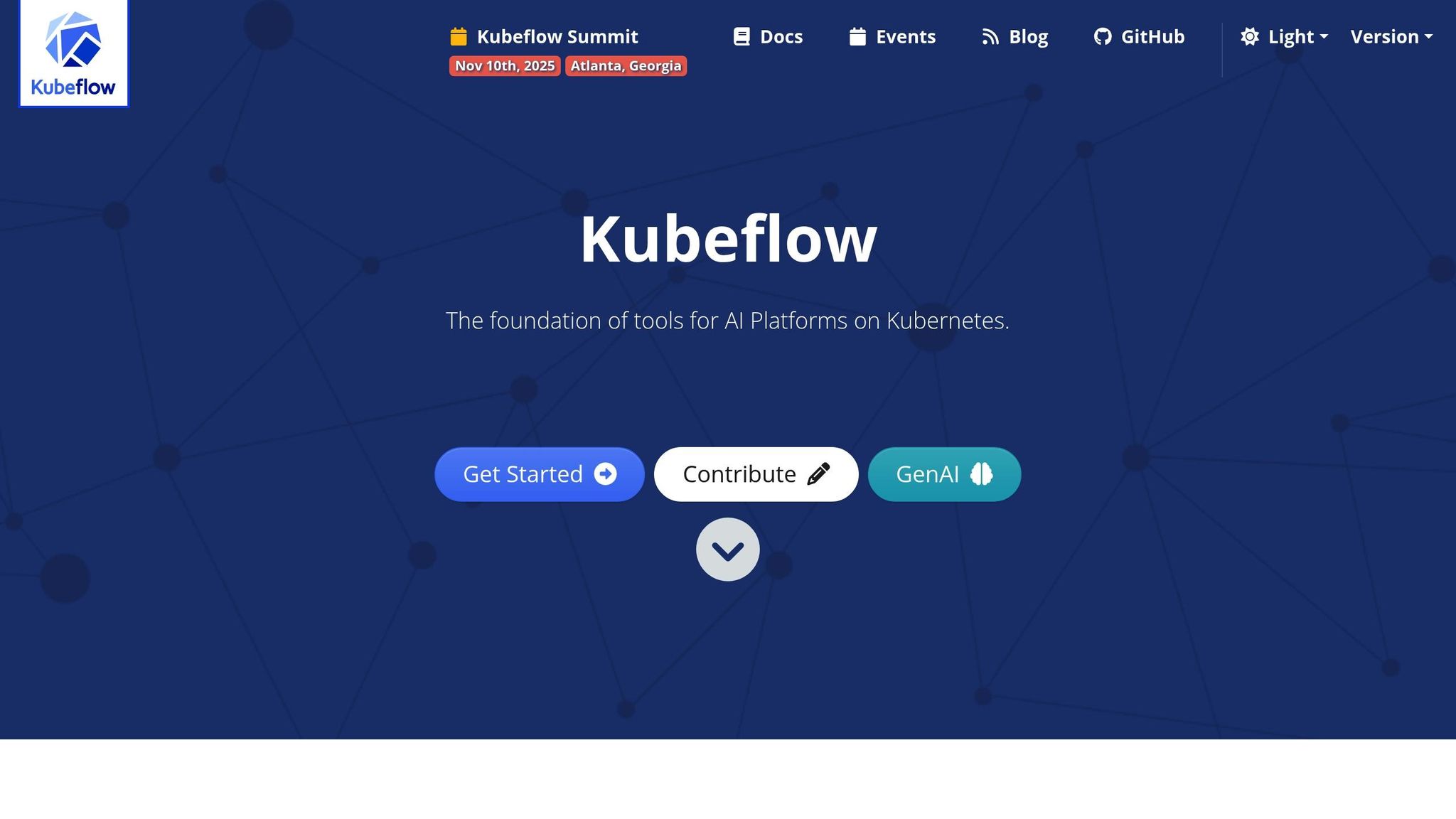
Kubeflow has emerged as a go-to platform in the world of machine learning (ML), offering a seamless way to integrate tools and simplify workflows. Designed specifically for Kubernetes environments, this open-source platform provides powerful orchestration capabilities tailored for AI workflows.
Kubeflow supports a wide range of ML frameworks, including TensorFlow, PyTorch, XGBoost, and even custom tools. This flexibility allows teams to create reusable, modular components that work across both cloud-based and on-premises setups. Its modular architecture ensures that workflows are not only portable but also easy to integrate, laying a solid foundation for automating complex pipelines.
By extending Kubernetes functionality, Kubeflow automates the entire ML lifecycle, from data preprocessing to model deployment. For example, enterprises can use Kubeflow pipelines to automate tasks like distributed GPU training and deploying models at scale. This automation handles critical aspects such as resource allocation, version control, and scaling, while also enabling automatic retraining of models when new data becomes available.
One of Kubeflow's standout features is its ability to scale effortlessly, thanks to Kubernetes. It enables horizontal scaling across clusters and supports distributed training and serving by dynamically managing resources like nodes and GPUs. Additionally, custom operators and plugins allow seamless integration with cloud services and storage solutions, creating a unified environment for managing ML projects.
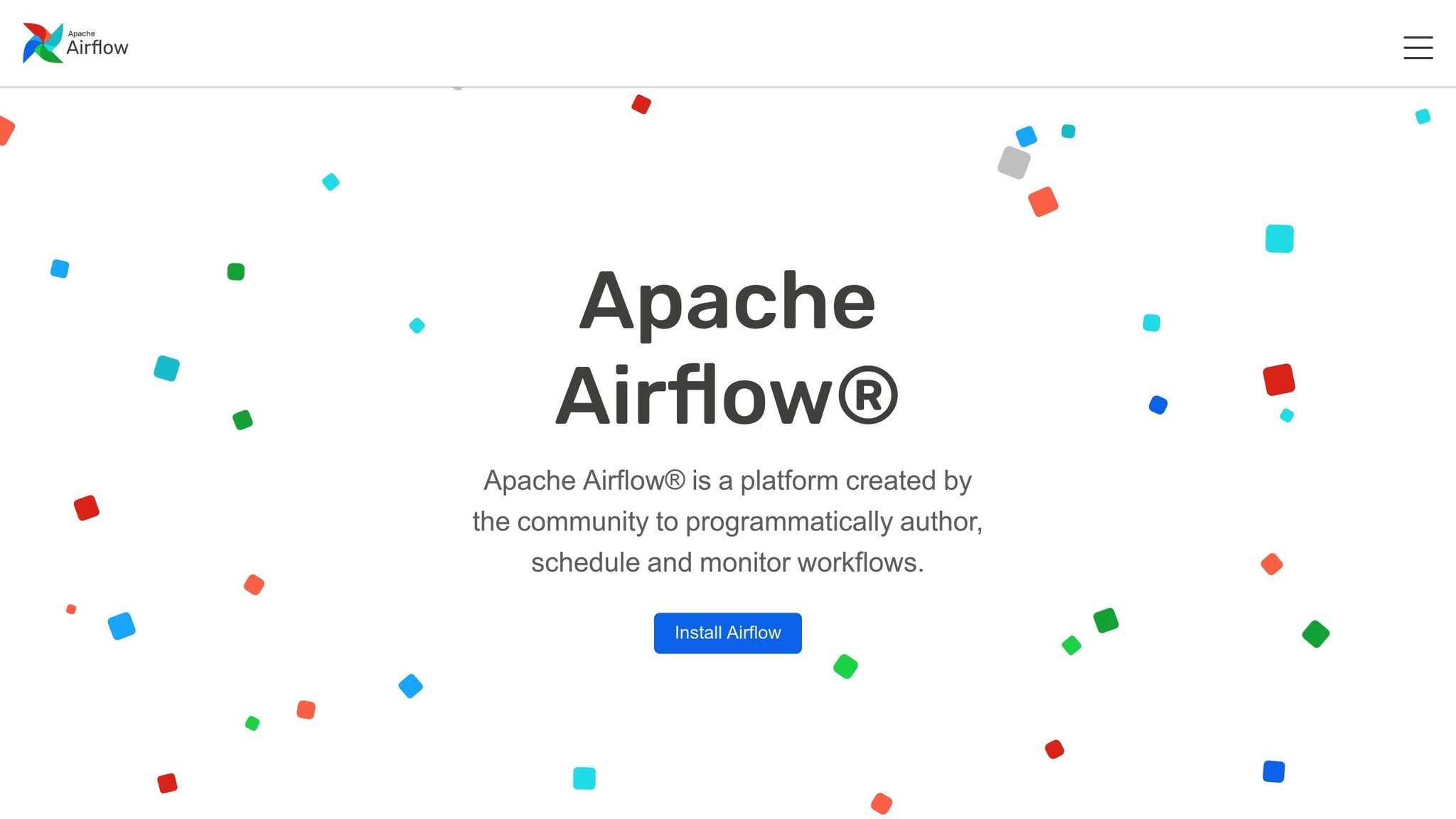
Apache Airflow is a widely-used open-source platform that has transformed the way organizations manage intricate data and AI workflows. Built on Python, it enables seamless orchestration of workflows, ranging from straightforward tasks to highly complex pipelines, and is trusted by thousands of companies worldwide.
At the heart of Apache Airflow is its Directed Acyclic Graph (DAG) approach, which structures workflows into a series of tasks with clearly defined dependencies. This structure provides an intuitive way to visualize and manage even the most intricate pipelines. For data scientists, this means automating processes such as data ingestion, preprocessing, model training, and deployment with ease.
One of Airflow’s standout features is its dynamic pipeline generation. Using Python, teams can programmatically create workflows that adapt in real-time to factors like data availability, model performance, or evolving business needs. For instance, a machine learning pipeline can be configured to automatically retrain a model if accuracy drops below a set threshold or when fresh training data becomes available.
Airflow’s flexibility extends to how workflows are triggered. It supports everything from simple cron-based schedules to intricate conditional triggers. Workflows can start based on time intervals, file arrivals, external events, or the completion of upstream tasks. Additionally, built-in retry mechanisms and failure handling ensure workflows remain resilient, making Airflow a reliable choice for scaling AI operations.
Apache Airflow is designed to grow with your needs, offering multiple execution modes to handle workloads of all sizes. The LocalExecutor is ideal for smaller teams or development environments, while the CeleryExecutor enables distributed execution across multiple worker nodes. For cloud-based setups, the KubernetesExecutor dynamically creates pods for individual tasks, ensuring efficient resource use and task isolation.
Its horizontal scaling capability allows organizations to manage increasing workloads by simply adding more worker nodes. Task parallelization further enhances efficiency by enabling independent tasks to run simultaneously, significantly cutting down execution times - especially useful when processing large datasets or running multiple model training experiments.
Airflow also includes robust resource management tools. Administrators can set specific resource requirements for tasks, ensuring resource-heavy jobs don’t overwhelm the system while critical workflows get the computational power they need. As workloads grow, these features ensure that Airflow remains efficient while maintaining oversight and compliance.
Governance is a key strength of Apache Airflow, offering detailed audit trails that capture every aspect of workflow execution. From task start and end times to failure reasons and data lineage, this level of transparency is invaluable. It helps teams understand how models were trained, what data was used, and when specific versions were deployed - critical for maintaining accountability.
Airflow also features role-based access control (RBAC) to secure sensitive workflows and ensure only authorized users can access specific tasks. Its data lineage tracking capabilities further support compliance with regulations, offering clear insights into how data moves through AI pipelines.
Airflow provides tools to monitor and optimize the cost of running AI workflows. Through detailed execution logging, teams can pinpoint bottlenecks, track resource usage, and identify inefficiencies. Features like task retry and backoff strategies minimize unnecessary resource consumption by intelligently handling failures. Additionally, resource pooling ensures that concurrent tasks don’t overuse computational resources, preventing costly overlaps in AI training jobs.
Selecting the right AI orchestration platform depends on your organization's goals, technical resources, and budget. From enterprise-grade solutions to open-source alternatives, each option comes with distinct benefits and challenges.
Enterprise-Grade Platforms, such as Prompts.ai, excel in providing centralized access, rigorous governance, and dependable support. They feature unified interfaces for managing multiple AI models, built-in compliance tools, and dedicated assistance. However, these platforms often come with higher upfront costs, making them a more substantial investment.
Cloud-Native Solutions, like OpenAI, Anthropic, and Google's Gemini, are known for their scalability and access to cutting-edge models. Their pay-as-you-go pricing structure makes them appealing for experimentation, but costs can rise sharply with increased usage. Additionally, these platforms may lack robust orchestration features, often necessitating additional tools to manage complex workflows.
Specialized Infrastructure Platforms, such as Groq and Together AI, are designed for high-performance inference and model serving. They deliver exceptional speed and efficiency but typically require significant technical expertise. Organizations often need to build an orchestration layer to support full workflow management, adding to the complexity.
Open-Source Solutions, including Kubeflow and Apache Airflow, offer unmatched flexibility and lower initial costs. These platforms are ideal for organizations with skilled technical teams capable of handling customization and ongoing maintenance. However, the total cost of ownership can increase when factoring in personnel and infrastructure requirements.
| Platform Category | Best For | Key Strengths | Main Limitations |
|---|---|---|---|
| Enterprise-Grade | Large organizations, regulated sectors | Governance, unified interface, support | High upfront costs |
| Cloud-Native | Rapid prototyping, AI-first teams | Scalable pricing, cutting-edge models | Limited orchestration, rising costs |
| Infrastructure-Focused | High-performance, technical teams | Speed, specialized optimization | Requires additional tools, technical complexity |
| Open-Source | Cost-conscious, custom needs | Flexibility, no licensing fees | High maintenance, expertise required |
Local Deployment Options, such as Ollama, cater to privacy-focused environments or teams working with sensitive data. These solutions can eliminate cloud-related costs and are well-suited for early-stage prototyping. However, they often lack the scalability and features offered by cloud-based platforms.
For small teams and startups, open-source or affordable cloud-based options provide a cost-effective entry point, offering flexibility to grow as the organization expands. These solutions minimize initial investment while leaving room for scaling operations.
Each platform category has its own trade-offs, making it essential to align your choice with your organization's operational needs. For large enterprises, especially those in regulated industries, investing in specialized platforms with higher costs often pays off through improved governance, compliance, and dedicated support. These features help reduce risks and enhance efficiency over time.
When choosing a platform, balance your current needs with your long-term goals. Consider factors like regulatory requirements, technical capabilities, and future growth to ensure your AI workflows remain streamlined and interoperable.
As we look ahead to 2025, the AI orchestration landscape offers a variety of solutions tailored to meet the unique needs of different teams, from ensuring compliance in regulated industries to achieving cost efficiency. The key lies in selecting an approach that aligns with your organization’s specific requirements.
For large enterprises in sectors like healthcare or finance, platforms such as Prompts.ai provide a strong foundation. With features like unified governance, stringent compliance measures, and dedicated support, these solutions ensure centralized control over AI workflows while adhering to strict security protocols. This aligns with our earlier review of Prompts.ai’s integrated and secure ecosystem.
Smaller teams and startups, on the other hand, will benefit from flexibility and cost-conscious solutions. Open-source tools like Apache Airflow or Kubeflow are ideal for technically skilled teams, offering scalability as the organization grows. These tools reflect the strengths highlighted in our earlier assessments.
Teams focused on rapid innovation can turn to cloud-native platforms such as OpenAI or Anthropic. These are excellent for prototyping and scaling quickly, though additional orchestration tools may be needed as workflows become more complex.
For privacy-sensitive organizations managing confidential data, local deployment options like Ollama are worth considering. As discussed in our analysis, local-first approaches provide enhanced control and security for sensitive workflows.
Ultimately, the right choice depends on your current needs and future goals. Evaluate factors like your team’s technical expertise, compliance obligations, and budget constraints. It’s important to remember that the most expensive option isn’t always the best fit. Instead, focus on platforms that integrate seamlessly with your workflows and can evolve alongside your organization.
Select solutions that not only meet today’s needs but also adapt as your AI capabilities grow and your operational landscape shifts.
When choosing an AI orchestration platform in 2025, businesses should focus on how well it integrates with their current tools and workflows. Look for platforms that offer automation features to handle repetitive tasks efficiently, saving both time and effort.
Security and governance should also be top priorities. Ensure the platform has strong security protocols and robust governance tools to protect your data and maintain compliance with regulations.
Another important factor is the platform's ability to adapt to future needs. Features like modular design and extensibility can help your business scale and adjust as requirements change. Lastly, a user-friendly interface is essential - it can streamline onboarding and help your team work more effectively from day one.
Prompts.ai is built to help businesses meet crucial regulatory standards like GDPR and HIPAA. With advanced security protocols, robust data encryption, and strict access controls, the platform ensures that sensitive information remains protected and private.
The platform also offers tools for creating audit trails and tailoring workflows, making it easier for users to align their AI operations with specific regulatory needs. By focusing on data security and clear processes, Prompts.ai helps organizations stay compliant across a range of industries.
Open-source AI orchestration tools can be a game-changer for startups and small teams working with tight budgets. Since these tools are often free, they provide a budget-friendly way to handle complex AI workflows without relying on costly proprietary software.
What sets open-source platforms apart is their flexibility and customizability. Teams can tweak and tailor these tools to meet their unique requirements, making them a practical choice for diverse projects. Another advantage is the backing of active developer communities. These communities not only offer regular updates but also share valuable insights and provide troubleshooting assistance. For startups looking to grow quickly, these tools can simplify operations and boost productivity - all without a hefty initial investment.


